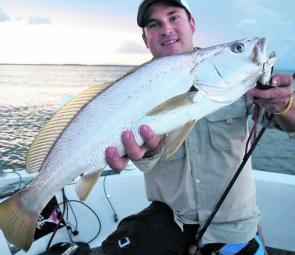This is why we love Queensland! If it’s not the muggy humid days we experience on a weekly basis, it’s speedy and frightening storms we seek refuge from that makes our state one of the most interesting places to live in as an angler. But with this kaleidoscope of weather patterns comes positivity on the fishing front, especially around the northern bay.
Estuaries are showing great form with good flathead and bream numbers in the upper reaches of all our creeks. The occasional rainy day pushes bait and their predators to the mouths and creek entrances rewarding anglers who have their finger on the pulse.
The spike in temperatures has also brought out everyone’s friend (or foe) the prized mangrove jack with anglers wising up to their ways and producing good catches in noted hotspots.
Summer whiting have definitely made their presence known with numbers fluctuating as regularly as Aussie cricket team scores, but anglers have been more than proud of what they can score in a session.
Estuary cod have been the surprise of late. This noted warmer weather roamer surprised anglers with appearances in unfamiliar places leaving fishers gobsmacked at their presence.
Let’s see what has been going on around our northern bay.
Night stalkers have been rewarded with decent mulloway and king threadfin salmon coming out of the deeper expanses of the river closer towards the mouth.
Larger plastics and vibration baits are fashioning the way this summer. Z-Man StreakZ and SwimmerZ, Atomic Plazo Jerk Minnows and Shads Lures Flicktails are certainly the pick of the plastics and for the lure minded amongst us Atomic Semi Hard Vibes, Shads Jew Candys and Jackall Mask Vibes have yielded good returns.
If chasing flathead and bream in the river it’s hard to go past the reclaimed rock wall on the western and northern sides and the middle sunken wall on the high tides. Ensure you are there for the top of the tide as fish flood up to these areas to feed.
Redcliffe Peninsula has been the standout this month with anglers braving southeast winds and producing good catches in the early and last of the daylight hours. After a good winter on the snapper front, the odd table-sized juvenile snapper has still been caught with fishos encountering good-sized bream and tailor at the same time.
Bream numbers have patchy of late with the disappearance of bait schools but numbers have been found towards the southern end of the peninsula around Woody Point and Clontarf.
Also down that end of the Peninsula locals have been getting amongst the summer whiting at Suttons Beach with bloodworms being the pick of the baits.
As water temps are on the rise, the presence of weed has diminished slowly bringing the flathead out of the creeks and rivers into the Peninsula seeking variety in their feeding prey. Hotspots for flathead have been the mouth of Newport Waterways, Queens Beach, the Wells under the northern end of the Ted Smout Bridge and the mouth of the Pine River under the Houghton Highway.
Mullet strips and pilchard halves have worked well for the baitos. For the lure fanatics, the normal bream lures and shad style lures have been working a treat.
The Pumicestone Passage has been the place to be for whiting as anglers finding the bottom end of the island quite fruitful. Red Beach, Buckleys Hole and Skirmish Point are the choice of the locals with bloodworms again doing the damage; bait and tackle shops are finding it hard to keep up with demand.
Bream numbers have been quiet of late in the passage but as the weather warms up the bream should be on the move to the upper reaches.
Flathead quantities have been rising also in the passage with the popular spots being Turners Creek Road and White Patch to name a few.
While these muggy days are becoming more frequent, so are the late afternoon storms. As people are ducking for cover on land to avoid lightning and even hail, be sure to stay safe if you happen to get caught out on the water. Seek refuge where possible and try to avoid fishing, as your favourite fishing rod can become your least favourite lightning rod!
With this safety warning comes a lighter side though. During this period of pre and post storm activity, anglers can experience the most electric (pardon the pun) and exciting fishing ever. This is usually due to a spike in barometric pressure just before a storm arrives, which fires fish into a feeding fenzy before the heavens open up. Elements of this barometric spike remain after the rains, keeping the fishing at its premium for a good 30-40 minutes. So next time you are caught in a storm don’t just get ready to keep dry, get ready for some great fishing.
Reads: 1327
This 61cm flathead was taken on the surface.

As the weather warms up the bream should be on the move to the upper reaches.

Anglers have been rewarded with decent mulloway throughout the Brisbane River.




